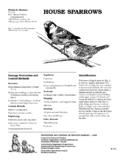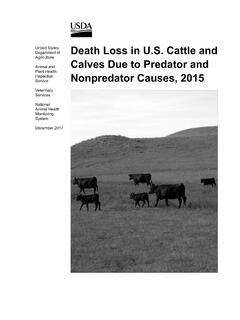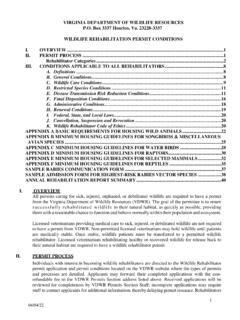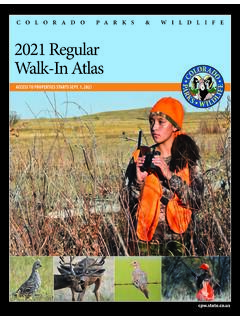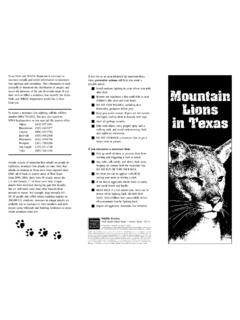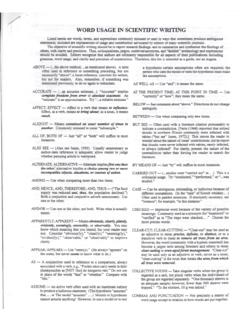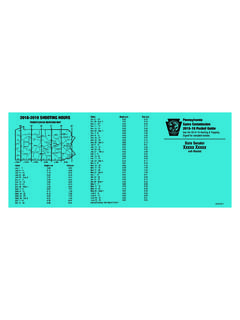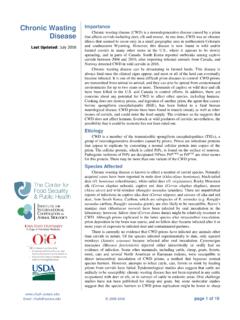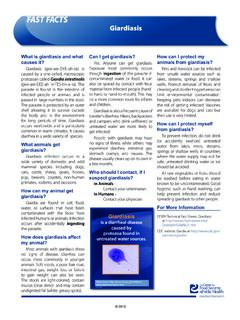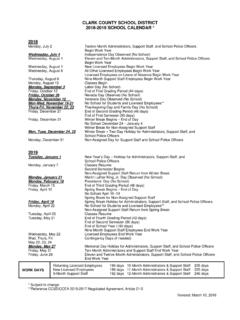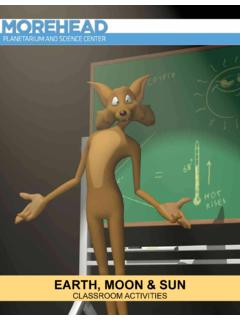Transcription of Coyotes - ICWDM Home Page
1 Jeffrey S. Green Assistant Regional Director USDA-APHIS- Coyotes . Animal Damage Control Lakewood, Colorado 80228. F. Robert Henderson Extension Specialist Animal Damage Control Kansas State University Manhattan, Kansas 66506-1600. Mark D. Collinge State Director USDA-APHIS- Animal Damage Control Boise, Idaho 83705. Fig. 1. coyote , Canis latrans Damage Prevention and Shed lambing, kidding, and calving Toxicants usually reduce coyote predation. Control Methods M-44 ejector devices for use with Remove carrion to help limit coyote sodium cyanide-loaded plastic Exclusion populations. capsules. They are most effective Produce livestock in confinement.
2 Frightening Agents and during cold weather (fall to spring). Repellents Livestock protection collars (LPC). Herd livestock into pens at night. Guarding dogs: Some dogs have containing Compound 1080. Exclusion fences (net-wire and/or (sodium monofluoroacetate) are electric), properly constructed and significantly reduced coyote predation. registered for use only in certain maintained, can aid significantly in states. reducing predation. Donkeys and llamas: Some are aggressive toward canines and have Fumigants Cultural Methods and Habitat Modification reduced coyote predation. Gas cartridges are registered as a Sonic and visual repellents: Strobe burrow (den) fumigant.
3 Select pastures that have a lower incidence of predation to reduce lights, sirens, propane cannons, and Trapping exposure of livestock to predation. others have reduced predation on both sheep and calves. Leghold traps (Nos. 3 and 4) are Herding of livestock generally reduces effective and are the most versatile predation due to human presence Chemical odor and taste repellents: control tool. during the herding period. None have shown sufficient effectiveness to be registered for Snares are effective where Coyotes pass Change lambing, kidding, and calving use. through or under net-wire fences seasons. and in trail sets.
4 PREVENTION AND CONTROL OF WILDLIFE DAMAGE 1994. Cooperative Extension Division Institute of Agriculture and Natural Resources University of Nebraska - Lincoln United States Department of Agriculture Animal and Plant Health Inspection Service Animal Damage Control C-51. Great Plains Agricultural Council Wildlife Committee Shooting Aerial hunting is effective in removing Other Methods Coyotes where terrain, ground Shooting from the ground is effective. cover, vegetation, regulations, and Denning: Remove adult Coyotes and/. Use rabbit distress calls or mimic landownership conditions permit. or their young from dens.
5 Howling or other coyote sounds to Hunting with dogs is effective for trail- bring Coyotes within shooting ing Coyotes from kill sites, locating distance. dens, running Coyotes , and assisting with aerial hunting or calling. Identification Habitat weaker lambs are also present. Usu- ally, the stronger lamb is on the In body form and size, the coyote Many references indicate that Coyotes periphery and is more active, making (Canis latrans) resembles a small collie were originally found in relatively it more prone to attack than a weaker dog, with erect pointed ears, slender open habitats, particularly the grass- lamb that is at the center of the flock muzzle, and a bushy tail (Fig.)
6 1). lands and sparsely wooded areas of and relatively immobile. Coyotes are predominantly brownish the western United States. Whether or coyote predation on livestock is gener- gray in color with a light gray to not this was true, Coyotes have ally more severe during early spring cream-colored belly. Color varies adapted to and now exist in virtually and summer than in winter for two greatly, however, from nearly black to every type of habitat, arctic to tropic, reasons. First, sheep and cows are usu- red or nearly white in some individu- in North America. Coyotes live in ally under more intensive manage- als and local populations.
7 Most have deserts, swamps, tundra, grasslands, ment during winter, either in feedlots dark or black guard hairs over their brush, dense forests, from below sea or in pastures that are close to human back and tail. In western states, typical level to high mountain ranges, and at activity, thus reducing the opportunity adult males weigh from 25 to 45 all intermediate altitudes. High densi- for Coyotes to take livestock. Second, pounds (11 to 16 kg) and females from ties of Coyotes also appear in the sub- predators bear young in the spring and 22 to 35 pounds (10 to 14 kg). In the urbs of Los Angeles, Pasadena, raise them through the summer, a pro- East, many Coyotes are larger than Phoenix, and other western cities.
8 Cess that demands increased nutri- their western counterparts, with males tional input, for both the whelping and averaging about 45 pounds (14 kg) and nursing mother and the growing females about 30 pounds (13 kg). Food Habits young. This increased demand corre- coyote -dog and coyote -wolf hybrids sponds to the time when young sheep Coyotes often include many items in exist in some areas and may vary or beef calves are on pastures or range- their diet. Rabbits top the list of their greatly from typical Coyotes in size, land and are most vulnerable to attack. dietary components. Carrion, rodents, color, and appearance.
9 Also, Coyotes in coyote predation also may increase ungulates (usually fawns), insects the New England states may differ in during fall when young Coyotes dis- (such as grasshoppers), as well as live- color from typical western Coyotes . perse from their home ranges and stock and poultry, are also consumed. Many are black, and some are reddish. establish new territories. Coyotes readily eat fruits such as These colorations may partially be due watermelons, berries, and other veg- to past hybridization with dogs and etative matter when they are available. General Biology, wolves. True wolves are also present In some areas Coyotes feed on human Reproduction, and in some areas of coyote range, particu- refuse at dump sites and take pets larly in Canada, Alaska, Montana, Behavior (cats and small dogs).
10 Northern Minnesota, Wisconsin, and Coyotes are opportunistic and gener- Coyotes are most active at night and Michigan. Relatively few wolves ally take prey that is the easiest to during early morning hours (especially remain in the southern United States secure. Among larger wild animals, where human activity occurs), and and Mexico. Coyotes tend to kill young, inexperi- during hot summer weather. Where enced animals, as well as old, sick, or there is minimal human interference Range and during cool weather, they may be weakened individuals. With domestic animals, Coyotes are capable of catch- active throughout the day.
